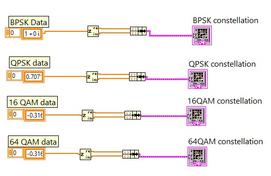Modulation Index Formula in AM/FM Communication Systems
Advertisement
Introduction
In communication systems, the modulation index is a crucial parameter that quantifies the extent of modulation in a signal. It determines the ratio between the amplitude of the modulating signal and the carrier signal in amplitude modulation (AM) or the frequency deviation in frequency modulation (FM).
Understanding the modulation index formula is essential for ensuring efficient signal transmission and reception. This guide explains the basics of the modulation index, its formula, calculation methods, and significance in communication systems.
As we know, for proper amplitude modulation, the modulating signal voltage should be less than the carrier voltage . Hence, the relationship between the amplitudes of these two signals is very important. This relationship is expressed in terms of the “modulation index” (‘m’). The term modulation index is also known by other terms such as modulating factor, modulation coefficient, or degree of modulation.
Before we understand the modulation index, let us understand AM and FM. AM is the short form of Amplitude Modulation, and FM is the short form of Frequency Modulation.
In AM, the carrier amplitude is varied in accordance with the modulating signal amplitude. In FM, the carrier frequency is varied in accordance with the modulating signal frequency.
Refer to AM vs FM vs PM and modulation basics for more information.
What is Modulation Index in AM?
Let us understand the modulation index in AM (Amplitude Modulation). The modulation index is the ratio of the modulating signal voltage () to the carrier voltage ().
The modulation index equation is as follows:
The modulation index should be a number between 0 and 1. When is greater than 1, severe distortion results in the modulated waveform. This condition results when is greater than , and it is also known as over-modulation.
The ideal condition is when is equal to and is equal to 1. In this situation, greater output is generated at the receiver with no or minimal distortion.
The modulation index can be calculated by knowing the modulating voltage and carrier voltage. But it is very common to measure the modulation index from the modulated waveform. The same can be viewed in the CRO (i.e., Oscilloscope).
After the modulated envelope is displayed in the Oscilloscope, and are noted down. Using this, and are derived using the following formulas or equations:
…Equation-1
…Equation-2
Now, the modulation index is calculated either by taking the ratio of to as mentioned in equation-3 below or directly using equation-4.
…Equation-3
…Equation-4
When the modulation index is multiplied by 100, the degree of modulation is expressed as a percentage. This is known as the percentage of modulation.
What is Modulation Index in FM?
Let us understand the modulation index in FM (Frequency Modulation). In FM, the modulation index is the ratio of frequency deviation () to the modulating frequency ().
It is expressed as follows:
Example:
Max. frequency deviation of carrier = +/- 25KHz Max. modulating frequency = 10 KHz
modulation index = 25/10 = 2.5
It is known as the deviation ratio when both and are used with the maximum value in the calculation.
Conclusion
The modulation index formula is fundamental to understanding how signals are modulated in communication systems. By learning its basics and significance, engineers can design and optimize systems for effective signal transmission. Whether applied to AM or FM, mastering this concept is key to achieving balance between signal quality and bandwidth efficiency in modern communication networks.
Advertisement
 RF
RF

